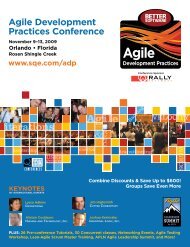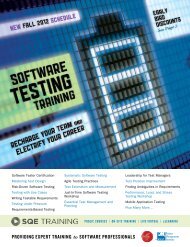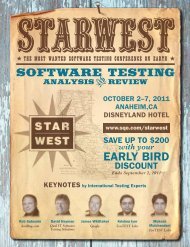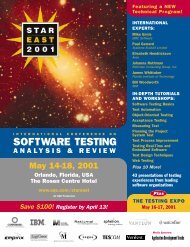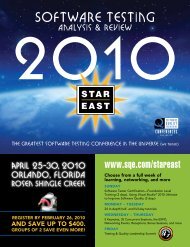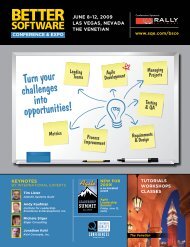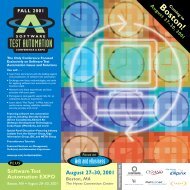SOFTWARE TESTING ANALYSIS & REVIEW - SQE.com
SOFTWARE TESTING ANALYSIS & REVIEW - SQE.com
SOFTWARE TESTING ANALYSIS & REVIEW - SQE.com
Create successful ePaper yourself
Turn your PDF publications into a flip-book with our unique Google optimized e-Paper software.
CONCURRENT SESSIONSMONDAY, MAY 16, 8:30-5:00THURSDAY, MAY 17, 1:30 p.m.T10TEST MANAGEMENTHow to Fake a Test ProjectJames Bach, Satisfice, Inc.It has never been easier to fool your manager into thinking that you're doing agreat job testing! James Bach covers all of today’s most respected test fakery.These techniques include: misleading test case metrics, vapid but impressivelooking test documentation, repeatedly running old tests "just in case they findsomething," carefully maintaining obsolete tests, methodology doublespeak,endless tinkering with expensive test automation tools, and taking credit for agreat product that would have been great even if no one had tested it. Jamescovers best practices for blame deflection. By the time you're through, yourexecutive management will not know whether to fire the programmers or thecustomers. But, you know it will not be you. (Disclaimer: It could be you if anoutsourcing <strong>com</strong>pany fakes it more cheaply than you do.)• Cautionary true stories of test fakery, both purposeful and accidental• Why surprisingly <strong>com</strong>mon practices often go surprisingly wrong• Signs that your testing may be fakeT11TEST TECHNIQUESWhen There‘s Too Much to Test:Ask Pareto for HelpClaire Caudry, Perceptive SoftwarePreventing defects has been our goal for years, but the changing technologylandscape—architectures, languages, operating systems, data bases, Webstandards, software releases, service packs, and patches—makes perfectionimpossible to reach. The Pareto Principle, which states that for manyphenomena 80% of the consequences stem from 20% of the causes, oftenapplies to defects in software. Employing this principle, Claire Caudry describesways to collect and analyze potential risks and causes of defects throughtechnology analysis, customer surveys, T-Matrix charting, Web trends reports,and more. Then, Claire discusses ways to provide adequate testing without ahuge financial investment—use of virtual machines, hardware evaluationprograms, vendor labs, and pre-release beta programs. Finally she discussesapproaches to minimize customer risk by proactive <strong>com</strong>munication of knowntechnology and third-party issues without getting into a “blame game” withyour vendor partners.• Applying the 80/20 rule to testing priorities• Methods to collect and analyze changing technology and customer platformrequirements• Testing options without additional automation and hardware purchasesT12TEST AUTOMATIONVerification Points for Better Testing EfficiencyDani Almog, AmdocsMore then one-third of all testing time is spent verifying test results—determiningif the actual result matches the expected result within some pre-determinedtolerance. Sometimes actual test results are simple—a value displayed on ascreen. Other results are more <strong>com</strong>plex—a database that has been properlyupdated, a state change within the application, or an electrical signal sent to anexternal device. Dani Almog suggests a different approach to results verification:separating the design of verification from the design of the tests. His test casesinclude “verification points,” with each point associated with one or moreverification methods, which can later be used on different test cases andoccasions. Some of the verification methods are very simple numerical or textual<strong>com</strong>parison; others are <strong>com</strong>plex; such as photo <strong>com</strong>parison. Dani describes alarge test automation project in which he used verification points and reports hissuccess in terms of reduced cost and time—and increased accuracy.• The benefits of verification points to test efficiency and accuracy• Techniques for designing verification points• Evaluate the use of verification points within your testingT13PERSONAL EXCELLENCEThe Nine ForgettingsLee Copeland, Software Quality EngineeringPeople forget things. Simple things like keys and passwords and the names offriends long ago. People forget more important things like passports andanniversaries and backing up data. But Lee Copeland is concerned with thingsthat the testing <strong>com</strong>munity is forgetting—forgetting our beginnings, thegrandfathers of formal testing and the contributions they made; forgettingorganizational context, the reason we exist and where we fit in our <strong>com</strong>pany;forgetting to grow, to learn and practice the latest testing techniques; andforgetting process context, the reason that a process was first created butwhich may no longer exist. Join Lee for an explanation of the nine forgettings,the negative effects of each, and how we can use them to improve our testing,our organization, and ourselves.• Why we must constantly rediscover what we already know• How each forgetting limits our personal and organizational ability• The power we have to grow and to improveT14SOA <strong>TESTING</strong>A Unique Testing Approach for SOA SystemsEd Horst, AmberPointService Oriented Architecture (SOA) systems most often use services that areshared across different applications. Some services may even be supplied bythird-parties, outside the direct control of a project, system, or organization. Asthese services evolve, organizations face the issue of ensuring the continuingproper functionality and performance of their ever-changing SOA systems. Theimplication of even a minor change to a service is often not fully understooduntil the systems dependent on that service operate in production and then fail.Creating an environment in which all SOA systems dependent on a particularservice can be tested is virtually impossible. However, Ed Horst presents aunique approach to testing services that does not require a detailed knowledgeof the systems that use that service. Ed shares real-world examples oforganizations that have successfully managed service changes.• Pitfalls of changing an SOA system without adequate testing• A cost-effective way to test an entire set of dependent applications• Plan for change in a world of interconnecting service oriented architectures“This was a greatexperience for me andI really enjoyed theopportunity to discussthese topics with somany QA experts.”— Ionel Sararu, Software Quality Assurance AnalystWestJet Calgary, CanadaCALL 888-268-8770 OR 904-278-0524 TO REGISTER • WWW.<strong>SQE</strong>.COM/SEREG 19



